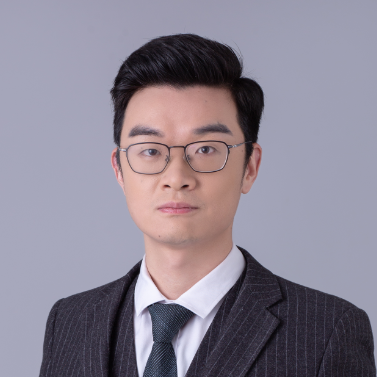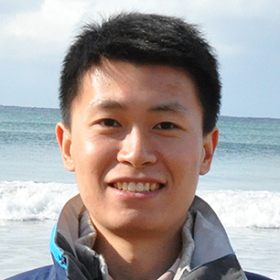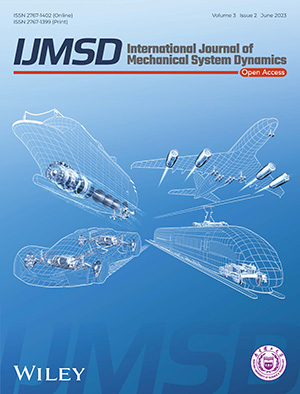IJMSD | 武汉大学王度教授、刘胜教授等:用于揭示激光-材料间相互作用动力学现象的超快成像
本文来源于Int J Mech Syst Dyn,欢迎浏览!

Keywords:
high‐energy‐density physics,
laser–material interaction,
laser processing,
ultrafast dynamics,
ultrafast imaging
DOI: 10.1002/msd2.12024
Cite this article: Wang D, Wei S, Yuan X, et al. Ultrafast imaging for uncovering laser–material interaction dynamics. Int J Mech Syst Dyn. 2022; 2(1): 65-81.
欢迎点击此处阅读原文!

Ultrafast imaging for uncovering laser-material interaction dynamics. The inserts are reproduced with permission from Ref.[1-3], Copyright 2016, The Optical Society; Copyright 2018, 2019, AAAS
[1]Ma B, Lu M, Wang K, et al. Depth position recognition-related laser-induced damage test method based on initial transient damage features. Optics Express. 2016; 24(16): 17698-17710. doi: 10.1364/OE.24.017698.
[2]Wang Q, Jiang L, Sun J, et al. Structure-mediated excitation of air plasma and silicon plasma expansion in femtosecond laser pulses ablation. Research. 2018; 2018. doi: 10.1155/2018/5709748.
[3]Cunningham R, Zhao C, Parab N, et al. Keyhole threshold and morphology in laser melting revealed by ultrahigh-speed X-ray imaging. Science. 2019; 363(6429):849-852. doi: 10.1126/science.aav4687.
激光是20世纪最重要的发明之一,它提高了人们的科研生产能力和生活质量。随着激光技术的不断进步,激光器的输出功率显著提高。例如,连续光纤激光器已实现单纤万瓦的输出功率,通过合束可获得超过100 kW的连续输出,在激光加工、激光武器等领域有着广泛应用。对于高能脉冲激光器,现已能产生高达1 MJ(106 J)单脉冲能量的纳秒激光脉冲,以及峰值功率达10 PW(1016 W)的飞秒激光脉冲。高功率激光光源的发展造就了一系列新的前沿交叉学科,包括惯性约束聚变(ICF)、激光驱动粒子加速器、强场量子电动力学和激光材料加工等。对于其中的许多主题,高功率激光与材料之间的相互作用提出了新的基础物理问题。除了理论分析外,基于直接成像的超快动力学过程观测是理解光与物质相互作用中很多基本问题的重要手段。在激光与物质相互作用的过程中,光激发电子的热化时间在飞秒量级,声子弛豫发生在皮秒量级,热扩散和冲击波的产生范围在几十皮秒到纳秒量级,而熔池的动力学过程发生在微秒量级。传统阵列传感器(如CCD和CMOS)的帧速率不足以对上述超快动力学现象进行高速时间分辨摄影。为克服这一不足,各种不同应用场景的超快成像技术正在迅速发展。
武汉大学刘胜教授团队和日本东京大学Keisuke Goda教授共同在《国际机械系统动力学学报(英文)》(International Journal of Mechanical System Dynamics, IJMSD)发表“用于揭示激光-材料间相互作用动力学现象的超快成像”综述,重点回顾了3种常用超快成像方法的原理和应用,包括泵浦探测成像技术、X射线诊断技术和单发光学超快成像技术,分析了每种成像技术自身的优势和局限。该文将讨论聚焦于高功率激光的应用,包括强场物理、光学材料的损伤机理和激光加工过程等,重点关注材料损伤阈值以上的现象。文章最后指出以飞秒时间分辨光学偏振测量(FTOP)、时间顺序全光学映射成像(STAMP)等为代表的单发光学超快成像技术有可能成为未来新的实验观测手段,但其成像帧数等关键指标参数仍有待提高。该综述虽未涵盖全部超快成像技术,但仍可为相关领域的研究人员提供必要参考。
The laser is one of the most important inventions in the 20th century, which has profoundly improved scientific research capabilities and the quality of human life. With the continuous advancements in laser technology, the output power of lasers has been significantly increased. For example, the widely used fiber laser has achieved 10 kW-level continuous wave (CW) output with a single fiber, and over 100 kW laser power through beam combining technology, for broad applications in laser processing, laser weapons and other fields. The high-energy pulsed laser has been developed with a maximum of pulse energy of 1 MJ for the nanosecond laser, and approximately 10 PW peak power for the femtosecond laser. The introduction of the high-power laser source allowed creating a series of new frontier interdisciplinary subjects, including inertial confinement fusion (ICF), laser driven particle accelerator, strong field quantum electrodynamics, and laser material processing. For many of those topics, the interaction between the high-power laser and materials has resulted in new interesting and fundamental physics problems. In addition to theoretical analysis, direct imaging‐based observation of ultrafast dynamic processes is an important approach to understand many fundamental issues in laser–material interaction. In the process of laser–material interaction, the thermalization time of optically excited electrons is of the order of femtoseconds. Phonon relaxation occurs within several picoseconds, thermal diffusion and shock wave generation range from tens of picoseconds to nanoseconds, and the dynamics of molten pool occurs of a microsecond order. The frame rate of conventional array sensors, such as charge‐coupled devices (CCDs) and complementary metal oxide semiconductors (CMOSs), is not large enough for temporally resolved photography of the aforementioned ultrafast dynamics. A variety of ultrafast imaging technologies for different applications are thus being rapidly developed.
The team of Prof. Sheng Liu from Wuhan University and Prof. Keisuke Goda from University of Tokyo published a review entitled "Ultrafast imaging for uncovering laser–material interaction dynamics" in the International Journal of Mechanical System Dynamics (IJMSD). This paper reviews the principles and applications of three types of commonly-used ultrafast imaging methods, including pump–probe imaging technology, X‐ray diagnosis technology, and single‐shot optical imaging technology. The advantages and limitations of each ultrafast imaging technology are analyzed. The scope of discussion mainly focuses on the application of high-power laser, including strong-field physics, damage mechanisms, and laser processing methods. The process above the damage threshold was the main focus. Finally, it is pointed out that the single-shot burst imaging technique, such as femtosecond time‐resolved optical polarimetry (FTOP) and sequentially timed all‐optical mapping photography (STAMP), will become a reliable measurement method, while there are still some parameters, such as the number of frames, that need to be improved. This review can serve as a reference for researchers in related fields, despite difficulties in covering all the ultrafast imaging technologies.
该文亮点:
回顾了3种常用超快成像方法的原理和应用,并分析了各自的优势和局限;
聚焦高功率激光的应用,重点关注材料损伤阈值以上的现象;
展望超快成像领域未来可能的新实验观测方法。
Highlights:
The principles and applications of three types of commonly-used ultrafast imaging methods are reviewed. The advantages and limitations of each method are analyzed.
The scope of discussion mainly focuses on the application of high-power laser, emphasizing the process above the damage threshold.
Potential measurement methods for ultrafast imaging are predicted.
部分作者简介

王度
武汉大学工业科学研究院研究员、博士生导师,中国光学学会激光加工专业委员会委员,入选武汉市高层次人才计划。2013年毕业于华中科技大学光学与电子信息学院,获工学博士学位。主持/参与研制了千瓦级高功率CO2激光器、百毫瓦级高功率太赫兹激光器及其成像系统,相关成果分别获湖北省科技进步二等奖1项,军队科技进步二等奖1项、三等奖1项。承担国家自然科学基金、湖北省重点研发计划、湖北省揭榜挂帅项目等。主要从事高功率激光器、太赫兹科学与技术、激光先进制造等领域研究。

刘胜
武汉大学/华中科技大学教授/博导,现任武汉大学动力与机械学院院长、武汉大学工业科学研究院执行院长、微电子学院副院长。斯坦福大学博士,曾获评长江学者特聘教授,是首批国家杰青获得者,ASME Fellow、IEEE Fellow。以第一完成人获国家科技进步一等奖、国家技术发明奖二等奖、教育部技术发明奖一等奖等多项国内外奖项。主要从事集成电路、LED和微传感器封装及可靠性理论和前沿技术研究,取得了系统的原创性研究成果。发表论文被Web of Science (WoS)收录534篇,其中SCI收录207篇,WoS他引3192次,SCI他引2010次。被30多个国家的著名学者(包括70余名国际学会会士和10余名中国和美国院士)广泛引用。出版英文专著2部,授权发明专利129项。

雷诚
武汉大学教授/博导,现任武汉大学工业科学研究院副院长,获国家级高层次人才计划支持,兼任湖北省/武汉市激光学会常务理事,中国激光杂志社青年编委。2013年毕业于清华大学电子工程系,获博士学位。2015—2018年在日本东京大学任博士后研究员、助理教授,2018年9月加入武汉大学工业科学研究院。长期从事超快光学成像系统及其应用相关领域的研究工作,在大数据和人工智能技术高速发展的背景下,创造性地将超快激光显微成像技术、微流控技术以及基于人工智能的图像处理和分类技术相结合,提出了基于人工智能的无标记高速显微成像流式细胞分析技术,并在生物能源制备、细胞以及药物检测方面取得了初步的研究和应用成果。发表高水平学术论文30余篇,包括Cell、Nature子刊等高影响力期刊论文。并获得SPIE Photonics West 2016最佳论文奖,日本光学学会2017年度最佳论文奖,中国光学工程学2019年技术发明一等奖等。

《国际机械系统动力学学报(英文)》(International Journal Mechanical System Dynamics, IJMSD )由来自18个国家的21位院士、17位国际学会主席、20位国际期刊主编等69位科学家和国际出版巨头美国Wiley出版社合作创立。IJMSD 旨在为用机械系统动力学科学与技术为提升现代装备设计、制造、试验、评估和使用全生命周期性能提供先进的理论、软件、方法、器件、标准,为全球科学家和工程专家提供广泛的机械系统动力学国际交流平台。IJMSD 强调从“系统”视角及系统级工具理解动力学,所涉及的机械系统不仅包括各种不同尺度的机械系统和结构,还包括具有多物理场/多学科特征的综合机械系统。
如果篇首注明了授权来源,任何转载需获得来源方的许可!如果篇首未特别注明出处,本文版权属于 X-MOL ( x-mol.com ), 未经许可,谢绝转载!































 京公网安备 11010802027423号
京公网安备 11010802027423号